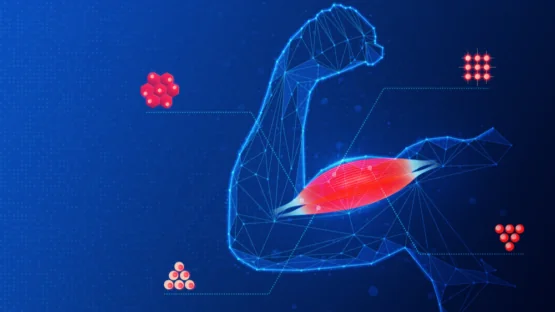A paper published today in Nature Aging has shown that a macrophage-regulating factor has a significant impact on muscle regeneration.
Healing slows with aging
The researchers note two key reasons for the decline of regenerative abilities with aging. The first is stem cell exhaustion, the gradual depletion of stem cells and ensuing lack of functional cells. The second, which this paper focuses on, is changes to the surrounding environment, the effects of which are the subject of well-known parabiosis experiments.
However, instead of experimenting with young blood as a whole, the researchers focus on just one of its factors: mesencephalic astrocyte-derived neurotrophic factor (MANF) [1], which declines with aging and has been shown to have positive effects on the retina [2] and other tissues [3].
A factor necessary for regeneration
The researchers created a population of mice that stopped producing MANF upon exposure to a hormone therapy. When the quadriceps of these mice were injured and MANF blocked, these mice were found to have substantially weaker regeneration, with fewer new muscle fibers, fewer muscle stem cells, and many more dead fibers remaining in the tissue.
This is explained by the cellular populations in the tissue. Mice without MANF2 were found to have roughly the same amounts of pro-inflammatory macrophages but far fewer macrophages associated with regeneration. By blocking MANF at different times, the researchers showed that this particular effect occurs while the animal is injured; temporarily blocking MANF before an injury did not have an effect.
Further experiments in cellular culture, using cells from wholly MANF-deficient mice, showed that MANF is essential to macrophages changing their phenotypes towards regeneration and away from inflammation. MANF was also found to be valuable for lysosomal degradation of foreign proteins, and macrophages without it were unable to properly respond to necrotic debris, which is a logical explanation for the dead fibers remaining in MANF-deficient mice.
Restoring age-related MANF decline
This study confirmed that old (22-24 months) mice have substantially fewer healing-oriented macrophages than young (2-6 months) mice. Gene expression analysis showed that their macrophages had some things in common with young, MANF-deficient macrophages, particularly the problems with lysosomal degradation, but the aged cells also had other problems with cellular movement structures.
The researchers performed their final and most crucial experiment, delivering recombinant MANF to aged mice. This treatment worked; macrophages were restored to youthful populations, necrotic fibers were more thoroughly cleared, and new muscle fibers were created in greater quantities.
MANF therapy at 4 μg i.m. resulted in a complete rescue of the repair-associated myeloid response.
Conclusion
While this is a mouse study, MANF appears to play the same basic biological role in human beings. Further work, development, and clinical trials will be necessary to determine if MANF-based treatments can restore health and function to old, damaged muscle tissue.
Literature
[1] Sousa-Victor, P., Neves, J., Cedron-Craft, W., Ventura, P. B., Liao, C. Y., Riley, R. R., … & Jasper, H. (2019). MANF regulates metabolic and immune homeostasis in ageing and protects against liver damage. Nature metabolism, 1(2), 276-290.
[2] Neves, J., Zhu, J., Sousa-Victor, P., Konjikusic, M., Riley, R., Chew, S., … & Lamba, D. A. (2016). Immune modulation by MANF promotes tissue repair and regenerative success in the retina. Science, 353(6294), aaf3646.
[3] JOntti, M., & Harvey, B. K. (2020). Trophic activities of endoplasmic reticulum proteins CDNF and MANF. Cell and Tissue Research, 382(1), 83-101.



